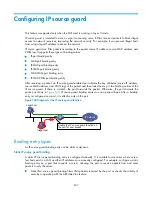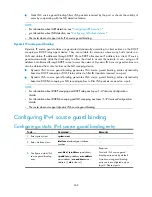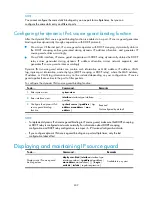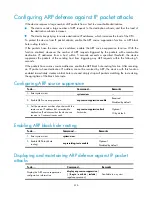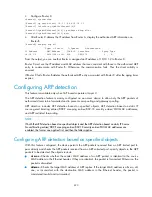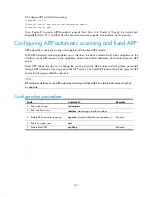
421
# Configure the DHCP server to support authorized ARP.
[RouterA-GigabitEthernet1/0/1] dhcp update arp
# Enable authorized ARP.
[RouterA-Ethernet1GigabitEthernet1/0/1] arp authorized enable
# Configure the aging time for authorized ARP entries.
[RouterA-GigabitEthernet1/0/1] arp authorized time-out 120
[RouterA-GigabitEthernet1/0/1] quit
2.
Configure Router B.
<RouterB> system-view
[RouterB] interface gigabitethernet1/0/1
[RouterB-GigabitEthernet1/0/1] ip address dhcp-alloc
[RouterB-GigabitEthernet1/0/1] quit
3.
After Router B obtains an IP address from Router A, display the authorized ARP entry information
on Router A.
[RouterA] display arp all
Type: S-Static D-Dynamic A-Authorized
IP Address MAC Address VLAN ID Interface Aging Type
10.1.1.2 0012-3f86-e94c N/A GE1/0/1 2 A
From the output, see that an IP address of 10.1.1.2 has been assigned to Router B.
After that, Router B must use the IP address and MAC address that are consistent with those in the
authorized ARP entry to communicate with Router A. Otherwise, the communication fails. Thus the client
validity is ensured.
If Router B fails, Router A deletes the authorized ARP entry associated with Router B after the aging timer
expires.
Authorized ARP on DHCP relay agent configuration example
Network requirements
, Router A acts as a DHCP server with an IP address pool of 10.10.1.0/24.
Router B is a DHCP relay agent, which conveys the IP address from the DHCP server to the DHCP client
(Router C). Enable authorized ARP on GigabitEthernet1/0/2 of Router B.
Figure 146
Network diagram for authorized ARP configuration
DHCP client
DHCP server
Router A
Router C
GE1/0/1
10.1.1.1/24
GE1/0/2
DHCP relay agent
Router B
GE1/0/1
10.1.1.2/24
GE1/0/2
10.10.1.1/24

